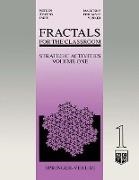Read more
This first volume of strategic activities is designed to develop through a hands-on approach, a basic mathematical understanding and appreciation of fractals. The concepts presented on fractals include self-similarity, the chaos game, and complexity as it relates to fractal dimension. These strategic activities have been developed from a sound instructional base, stressing the connections to the contemporary curriculums recommended in the National Council of Teachers of Mathematics' Curriculum and Evaluation Standards for School Mathematics. Where appropriate the activities take advantage of the technological power of the graphics calculator. These activites make excellent extensions to many of the topics that are already taught in the current curriculum. Together, they can be used as a complete unit or as the beginning for a semester course on fractals. TOC:1: Self-Similarity. 2: The Chaos Game. 3: Complexity
List of contents
Unit 1 Self-Similarity.- Key Objectives, Notions, and Connections.- Mathematical Background.- Using the Activities Sheets.- 1.1 Sierpinski Triangle and Variations.- 1.2 Number Patterns and Variations.- 1.3 Square Gasket.- 1.4 Sierpinski Tetrahedron.- 1.5 Trees.- 1.6 Self-Similarity: Basic Properties.- 1.7 Self-Similarity: Specifics.- 1.8 Box Self-Similarity: Grasping the Limit.- 1.9 Pascal's Triangle.- 1.10 Sierpinski Triangle Revisited.- 1.11 New Coloring Rules and Patterns.- 1.12 Cellular Automata.- Unit 2 The Chaos Game.- Key Objectives, Notions, and Connections.- Mathematical Background.- Using the Activities Sheets.- 2.1 The Chaos Game.- 2.2 Simulating the Chaos Game.- 2.3 Addresses in Triangles and Trees.- 2.4 Chaos Game and Sierpinski Triangle.- 2.5 Chaos Game Analysis.- 2.6 Sampling and the Chaos Game.- 2.7 Probability and the Chaos Game.- 2.8 Trees and the Cantor Set.- 2.9 Trees and the Sierpinski Triangle.- Unit 3 Complexity.- Key Objectives, Notions, and Connections.- Mathematical Background.- Using the Activities Sheets.- 3.1 Construction and Complexity.- 3.2 Fractal Curves.- 3.3 Curve Fitting.- 3.4 Curve Fitting Using Logs.- 3.5 Curve Fitting Using Technology.- 3.6 Box Dimension.- 3.7 Box Dimension and Coastlines.- 3.8 Box Dimension for Self-Similar Objects.- 3.9 Similarity Dimension.- Answers.

